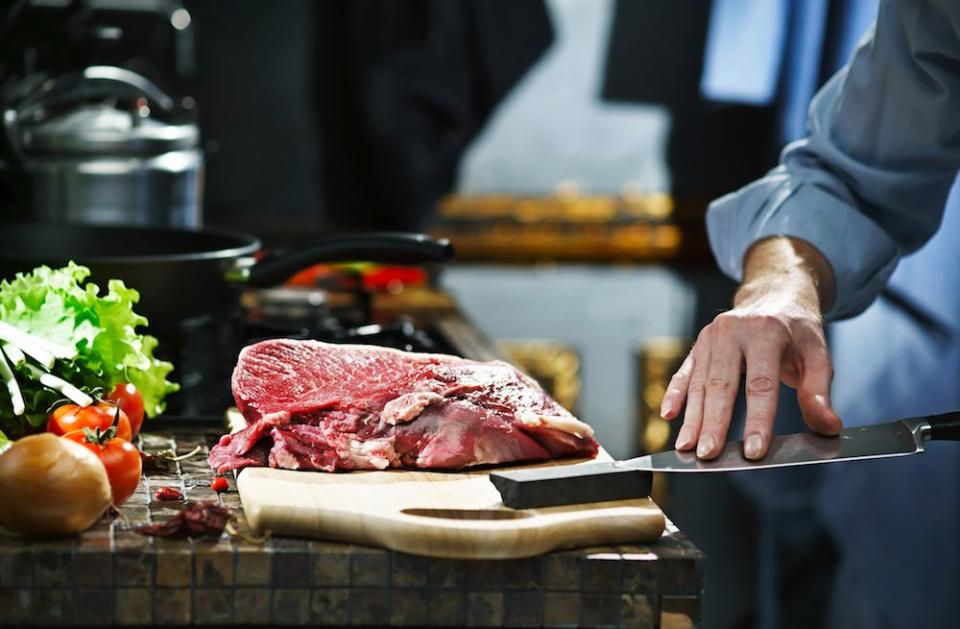How to Sharpen a Knife With a Whetstone, According to an Expert
Dotdash Meredith and Yahoo Inc. may earn commission or revenue on some items through the links below.
A knifemaker reveals how to expertly get your blades back to their sharpest state.

While there are various tools available to sharpen knives, whetstones are the most recommended tool by experts because they provide control and precision. Using a whetstone — or a sharpening stone — removes the least amount of material from the knife blade, which extends its lifetime.
Whetstones come in various types (wet and oil) and grits (ranging from 100 to 10,000). This number of variables may feel overwhelming initially, but it allows for customization at a level an electric or pull-through manual sharpener can’t match.
“A whetstone allows the user to carefully remove the steel off the cutting edge with the ability to adjust as you go through each pass,” says George Feder, a blacksmith and owner of Feder Knives and an award-winning knifemaker from the Hudson Valley. “It can be intimidating to find the angle and confidently and slowly remove the material on the edge. If you do it frequently, it requires less work.“
How whetstones work
Water and oil stones utilize a lubricant to limit friction during sharpening, which improves the result and prevents damage to the stone. Many chefs prefer a water stone to an oil stone because water facilitates efficient knife sharpening and is readily available.
As for grit, the larger the grit number, the sharper your knife’s edge will be, but the longer it will take to get the blade sharp. So, the higher the number, the slower and sharper; the lower the grit number, the faster and less sharp.
“To establish the edge, use finer grit stones to make the cutting edge of the bladeless resistant,” says Feder. “The finer the edge, the less resistance when cutting. The user can sharpen aggressively or gently with finesse.”
Transparently, having two stones is the best way to manage this variation, equipping you to sharpen almost any knife in any condition. We suggest a medium grit stone (700 to 1,000) to get your knife in working order and a fine grit stone (around 2,000) that allows you to achieve a razor-sharp edge.
Equipment you’ll need
We love the King Whetstone Starter Set best for beginners and regular users alike. It’s a really handy double-sided sharpener with two grit sizes, an angled holder, and a sturdy base.

Amazon
How to sharpen knives with a whetstone

Submerge your stone(s) in water for an hour.
Place your stone on a towel over a cutting board or stable surface. We suggest dedicating a towel to sharpening; you can store the stones in it, and rest assured, knife sharpening leaves a mark. You’ll also want to keep a dish of water nearby to keep the stone wet as your work. If your whetstone has a coarse and fine side, begin with the coarse side. If you use two stones of different grit, start with the one with the lower grit number.
Hold the knife with the handle in your dominant hand. Place the heel of your knife on the far edge of the stone, holding the blade at the desired angle (using an angle guide if needed). Applying even pressure, slowly pull the knife over the stone toward you. The blade should move smoothly across the stone. Lift the knife, reset the heel at the top of the stone, and repeat.
Count each pass made, so you’re keeping each side of the knife even and not accidentally taking more material off one side than the other. Repeat as few as ten times and as many as 50. As you work, the water will begin to turn cloudy. This gritty water helps your knife become sharper with each stroke. Continue to apply water from time to time; you want it to be runny.
Now it’s time to move to the second side of the knife. Simply turn it over and repeat as many strokes as you did on the first side, with the edge facing toward you. Push away from you, and let go when you pull the knife back to you.
Repeat the process with the higher grit if you have a second stone (or a stone with a higher grit on one side).
Allow your whetstone to dry on a rack in the open air for at least 24 hours with the towel. Then wrap the stones in the towel and store them.
Related:The Food & Wine Guide to Kitchen Knives
Our expertise
Christa Glennie has been a freelance writer and food editor for nearly 20 years. She is also the author of two cookbooks and specializes in food and drink trends, agriculture, the regional foodways of Western New York, and the restaurant business. Her respect for simplicity and uncluttered counters in the kitchen ultimately fuels a desire to find and own well-designed, multi-purpose, best-in-class kitchen tools. For this piece, she spoke to an award-winning knifemaker for expert advice.
For more Food & Wine news, make sure to sign up for our newsletter!
Read the original article on Food & Wine.

